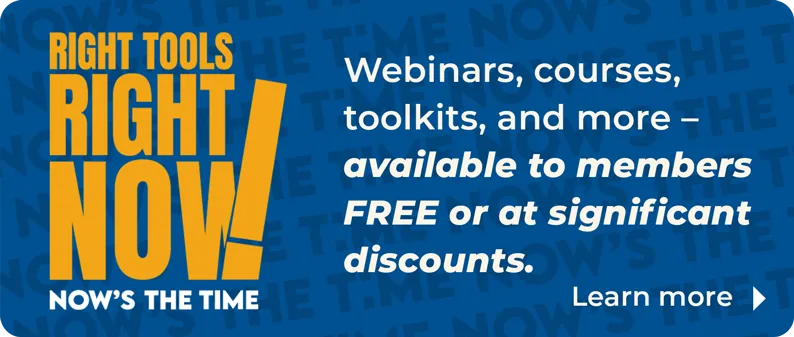
Mainstreet REALTORS® is a 19,000-member association in the vast Chicago suburbs. With so many members to reach and engage on a wide variety of topics and goals, effective communications can be challenging. If you run a small or even medium-sized association, you might view your challenges differently. But every REALTOR® association can benefit from a holistic approach to communications planning.
When I was in graduate school, we studied IMC, or integrated marketing communications. At the heart of IMC is the belief that communications and marketing aren’t all that different; they’re two sides of the same coin. For our associations, this is especially relevant. We don’t have time to figure out where communications end and marketing begins. Besides, I would contend that—in my honest opinion—all associations are essentially marketing organizations.
Whether we realize it or not, we’re constantly trying to persuade current and prospective members of this simple truth: The more they put into their association in terms of their own participation, involvement and engagement, the more they’ll get out of it. The value of our value proposition depends in part on them. But we have to reach them and gain their attention first.
That means going to where they are (using the right channels) and speaking in a language that’s relevant (using the right words) to connect.
With these goals in mind, let’s look at the basic steps of building a comprehensive communications and marketing plan for your association. (I’ll throw in some examples from Mainstreet at no extra charge.)
Step 1: Define Your Goals and Objectives

Using your strategic plan as your top-level guide, ask yourself: What do you want to achieve through your communications and marketing efforts? For example, are you looking to increase membership, promote events or raise awareness about an issue? The answer is probably all three plus a few more. By clearly defining the goals you want to achieve, you can tailor your communication strategies to meet these objectives effectively.
At Mainstreet, we’re typically marketing four distinct categories:
- Events: Networking, usually with a learning component
- Education: Classes and designation courses
- Benefits: Those included with membership, such as forms, technology and safety apps, and optional discounts on tools like customer relationship management and transaction management platforms
- Issues: Local, state and national issues members should know about
Some of our communications are combinations. For example, we now offer a popular CRM at a deep, members-only discount, along with free training on business planning and goal setting, including how to set up and use the CRM. Any member can take the training without buying the CRM. Our primary target for this program is newer members who have done at least one transaction—which brings up our next step.
Step 2: Identify Your Target Audience
Are you targeting new agents, brokers, top producers? Identifying those audiences and understanding their needs, preferences and communication channels will help you create targeted messages that resonate with them.
At Mainstreet, we’ve broken our membership down into six groups, based on where members are in their real estate careers, and designed programming specifically for each.
The cohorts are:
- Exploration
- Mid-career
- Career change
- Late career
- Established
- Withdraw
We create communication mini-plans (pathways) with specialized education and offerings to help members succeed and thrive as they progress through their careers. Most members probably don’t realize it, but they’re all part of a target audience, fitting within one of these cohorts.
Step 3: Conduct a Communications Audit
Before developing your full plan, it’s helpful to conduct a communications audit to assess your current efforts. Evaluate your organization’s existing communication channels, messaging and branding to identify areas for improvement. This audit will help you identify gaps in your communications strategy and develop a plan to address them effectively.
A couple of years ago, we hired an expert to develop and conduct a comprehensive communications audit for Mainstreet. It involved more than 70 hours of Zoom interviews with members and staff. The audit confirmed we were on the right track in many areas but off-target in others—especially coming out of the COVID-19 pandemic, since members’ expectations for education and networking had shifted dramatically. Most members wanted a Zoom option for education but still favored live events for networking.

Step 4: Develop a Content Calendar
A content calendar is a crucial tool for planning and organizing your communication efforts throughout the year. Create a calendar that outlines key events, campaigns and initiatives that you want to promote. Include important dates, deadlines and milestones to ensure that your communication efforts are timely and relevant. (See the section One More Piece of Advice in "Cutting Through the Noise.")
At Mainstreet, our allied partners—the multicultural real estate groups like the National Association of Hispanic Real Estate Professionals, Asian Real Estate Association of America, National Association of Real Estate Brokers, LGBTQ+ Real Estate Alliance and Women’s Council of REALTORS®—are very important to us. We strive to support their events and include them in ours. This takes extra planning, but it’s well worth it.
Of course, things will come up during the year that you hadn’t planned for, especially in these rapidly evolving times. But at least you’ll have two-thirds to three-quarters of your year mapped out ahead of time.
Step 5: Choose the Right Communication Channels
Selecting the right communication channels is essential for reaching your target audience effectively. Consider using a mix of traditional and digital channels—such as email newsletters, social media, websites and print materials. At Mainstreet, we also employ texting and automated voice calls to members. Tailor your messaging and content to fit each channel’s unique requirements and engage with your audience effectively.
This is perhaps the most difficult challenge because one size does not fit all. Different members have different needs and wants for how they wish to be reached. Your communication audit and ongoing listening efforts can help. One thing’s for sure, though: Email is now considered white noise. Readers tend to tune it out. So, if you’re relying almost solely on email to reach your members, you’ll want to diversify.











